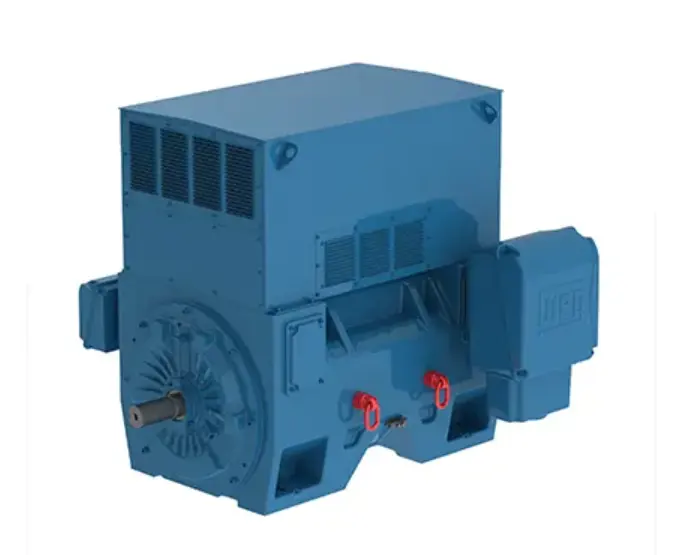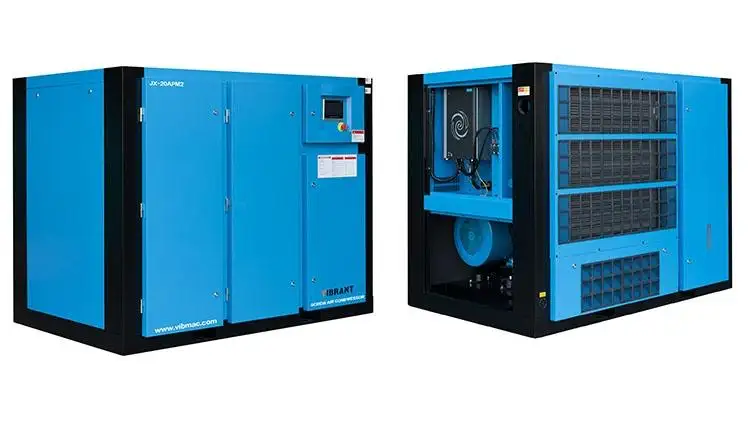
As one of the key power equipment of glass production, air compressor is responsible for the desulfurization and denitrification injection system, furnace wall, heat storage chamber cooling, cold end purging, instrument control gas, dust removal system and other gases. Air is compressible, after the air compressor does mechanical work, the volume decreases, and the pressure increases, which is called compressed air. Compressed air is an important source of power. Compared with other energy sources, it has obvious characteristics: clear and transparent, convenient transportation, no special harmful performance, no fire hazard, not afraid of overload, can work in many adverse environments, inexhaustible.
Although compressed air has the above characteristics as an energy source, its energy consumption to output ratio is about 1:7, which is a major energy consumer. To save energy and reduce consumption, first, we need to know the position and amount of gas used in the later period of the workshop, and then analyze the current situation of gas used. By adding solenoid valve, reducing direct blow loss, optimizing operation mode and pipeline flow control distribution, adjusting sewage control mode, reducing compressed gas pressure and other measures, we realize energy saving and consumption reduction. Our company analyze the gas consumption and discuss the optimization and operation efficiency of the pipeline system.
1. Point-of-use gas utilization
Due to the aging of the furnace and the continuous improvement of the production process requirements, the amount of compressed air used by our company has increased. Compressed air is mainly used for cooling furnace walls and heat storage chambers, and for blowing glass fragments, mildewproof powder, desulfurization, and denitrification spray. The increasing demand for compressed air not only seriously affects the efficiency of air compressors, but also increases production costs. At that time, the electricity consumption of air compressors accounted for 35% of the total electricity consumption of the company. Therefore, it is necessary to transform and optimize to reduce the cost expenditure. The compressed air operation of the three production lines is shown in Table 1.
| Table 1 Operation conditions of compressed air during operation of three production lines | |||
| Production line | Status of operation(m3/min) | Power(KW/h) | Output volume(m3/h) |
| Line 1 | 2 sets: 27, 1 set: 55 | 670 | 6540 |
| Line 2 | 2 sets: 34 | 400 | 4080 |
| Line 3 | 2 sets: 34 | 400 | 4080 |
| Total | 1470 | 14700 | |
| Average one-line | 490 | 4900 | |
2. Gas consumption analysis
Any transmission will generate a pressure drop, and proper control of the pressure drop is beneficial to save energy. When the pressure drops increases, the air compressor needs more work to obtain the required pressure. Through the study and analysis of the use of compressed air in the field, it is found that the mainline non-process gas has the following characteristics:
- Vacuuming, consuming about 300m³/h, is intermittent transient mode.
- Desulfurization denitrification blowing instrument control, consumption of about 1500m3/h, is intermittent transient mode.
- Cold end glass chips and anti-mold powder blowing, consumption of about 900 ~ 1200 m3/h, is continuous direct discharge mode.
- Gas for cooling the heat storage room at the hot end, consuming about 1500~2100 m3/h, is continuous direct discharge mode.
- Moisture discharge from compressors, cold dryers, and storage tanks in a continuous mode, taking away moisture and increasing the air supply at the same time.
At 0.65MPa, the direct discharge volume of compressed gas of DN20mm pipe diameter reaches 22m3/min, which is close to the operating power of 160KW screw air compressor (which can generate 27m3/min gas volume). Therefore, the use conditions of direct discharge are not energy saving, and the gas consumption is high, which has a great impact on the pressure drop of the whole process pipe network. The need to comprehensively consider the efficiency benefit of energy consumption to output ratio is the key issue to be solved.
The improvement focuses on reducing the pressure drop. There are two ways to reduce the pressure drop. One is enlarging the pipe diameter to increase the circulation. The second is reducing the consumption in the middle of the transmission pipeline. Firstly, measures to reduce intermediate consumption are taken, and the air used for purging in the later period is changed from direct discharge to intermittent control of the solenoid valve, so as to realize the instantaneous change of gas consumption. Secondly, the locations with shutdown conditions should stop as much as possible.
3. Improvement measures: Compressed Air
By studying the relationship between the output and consumption of compressed gas in the air compressor system, verifying the rated value deviation of each output, understanding the operation efficiency of each compressor in each production line, finding the key factors affecting the rated output, determining the relationship between the pipeline direction and load consumption, we basically formed a set of adjustment mechanisms to reduce pressure difference and maximize the operation efficiency.
3.1 Optimize compressed air piping system
After the exploration of single line control and large system network control, it is confirmed that the large system control can optimize and adjust the gas consumption of each line, and the centralized compensation function compensates for the frequent loading and unloading power consumption caused by wasteful over-opening and insufficient under-opening. The networked gas supply mode of the large system can complement each other and reduce the number of operating units.
3.2 Increase solenoid valve to reduce direct blowing loss
According to the process requirements, the air point which needs blow glass chips, is transformed into a solenoid valve control, controlling the amount of balance, increasing incremental air supply which the end of the local pressure drop seriously.
3.3 Reduce the amount of compressed gas used for kiln cooling
Reduce the use of gas for kiln cooling through measures such as brick tying.
3.4 Optimize operation mode and pipeline flow control distribution
According to the pipeline transport distance and compressor configuration conditions, configure and optimize the system air source reasonably. The main gas supply pipeline is connected by bypass mode, and the gas volume is evenly distributed to each gas path in the independent cylinder position, which solves the problem of unbalanced pressure difference between the front and rear ends.
3.5 Reduction of compressed gas water content
Due to the high humidity of the air, there is more water in the compressed air, especially the compressor room of Line 1 and Line 2 is only about 10m away from the cooling tower, and a large amount of water vapor is released and sucked in by the compressor, which affects the pressure drop. The problem of water vapor is firstly, it combines with the dust on the air filter element to form an isolation film, which affects the smoothness of air suction, resulting in a decrease in air production; secondly, the increased moisture needs to be discharged, which creates a loss of direct discharge. A variety of water vapor separation measures have been validated to reduce discharge, but none are ideal, so reducing the moisture content is critical. Condensate must be a high priority in the design and application of compressed air systems.
Determine the water content of the equipment drainage, storage tank drainage and cold-water drainage lines after the cold dryer, determine the valve opening, change normally open to switch depending on air humidity. The change of the intake channel reduces the air humidity in the compressor suction environment, and the entrance of the intake channel close to the cooling tower is closed, and the water volume is significantly reduced.
3.6 Adjustment of normally open discharge controls
In the absence of water or trace amounts of water vapor, you can turn off the control valve and instead use the location of the gas storage at the bottom of the tank outlet, to determine the frequency of drainage, and adjust the control valve in time to reduce water vapor emissions.
3.7 Reduce compressed air pressure
Compressed gas pressure control is an important factor affecting energy consumption. When the pressure increases by 0.01MPa, the power consumption increases by 0.03% ~ 0.05%. Low standard operation is the preferred channel for energy saving while satisfying the reasonable needs of all parties. To achieve low standard operation, it is first necessary to rationally optimize the gas production parameters and models of the equipment. Combined with 27m3 machine, the automatic loading function can be realized, the loading range can be appropriately reduced, and the output pressure is controlled at about 0.62MPa.
4. Effectiveness of Compressed Air
Through the above improvements, combined with the equipment operating parameters point inspection technology, the system optimization has got significant results, as shown in Table 2.
| Table 2 Operating conditions of compressed air when running four lines(line 4 has been ignited and put into operation) | |||
| Production line | Status of operation(m3/min) | Power(KW/h) | Output volume(m3/h) |
| Line 1 | 1 set: 27, 1 set: 34,1 set: 55 | 710 | 6960 |
| Line 2 | 2 sets: 34 | 400 | 4080 |
| Line 3 | 2 sets: 34 | 400 | 4080 |
| Total | 1510 | 15120 | |
| Average one-line | 378 | 3780 | |
By improving the quality of the gas, the water content of the compressed gas is reduced to a certain extent, which ensures the stable operation of the control instrument. It reduces the operating cost of the equipment, avoids the formation of wet compression, improves the working efficiency of the air compressor, reduces the consumption of electricity and water, improves the per-unit-gas-production of the equipment, avoids the startup and operation of multiple devices, and has obvious energy saving and emission reduction effect. According to the single line consumption calculation:
U = (A-B) · N · T · E
U - total annual savings of the four lines.
A - power consumption of a single line before adjustment.
B - power consumption of a single line after adjustment.
N - the number of production lines.
T - time.
E - electricity unit price (calculated according to the local average price of 0.67 RMB W·h).
U= (490-378) *4*24*365*0.67=2629401.6 RMB
Through the above improvement and optimization, our company can save 2.63 million RMB per year when running four lines.
5. Conclusion
Energy saving in compressed air systems still has a long way to go. Only by paying attention to every detail in the work and starting with the little things, can we reduce the energy consumption of the compressed air system, produce high-quality air source for the glass production process, improve the quality of products, and reduce production costs. Read more








